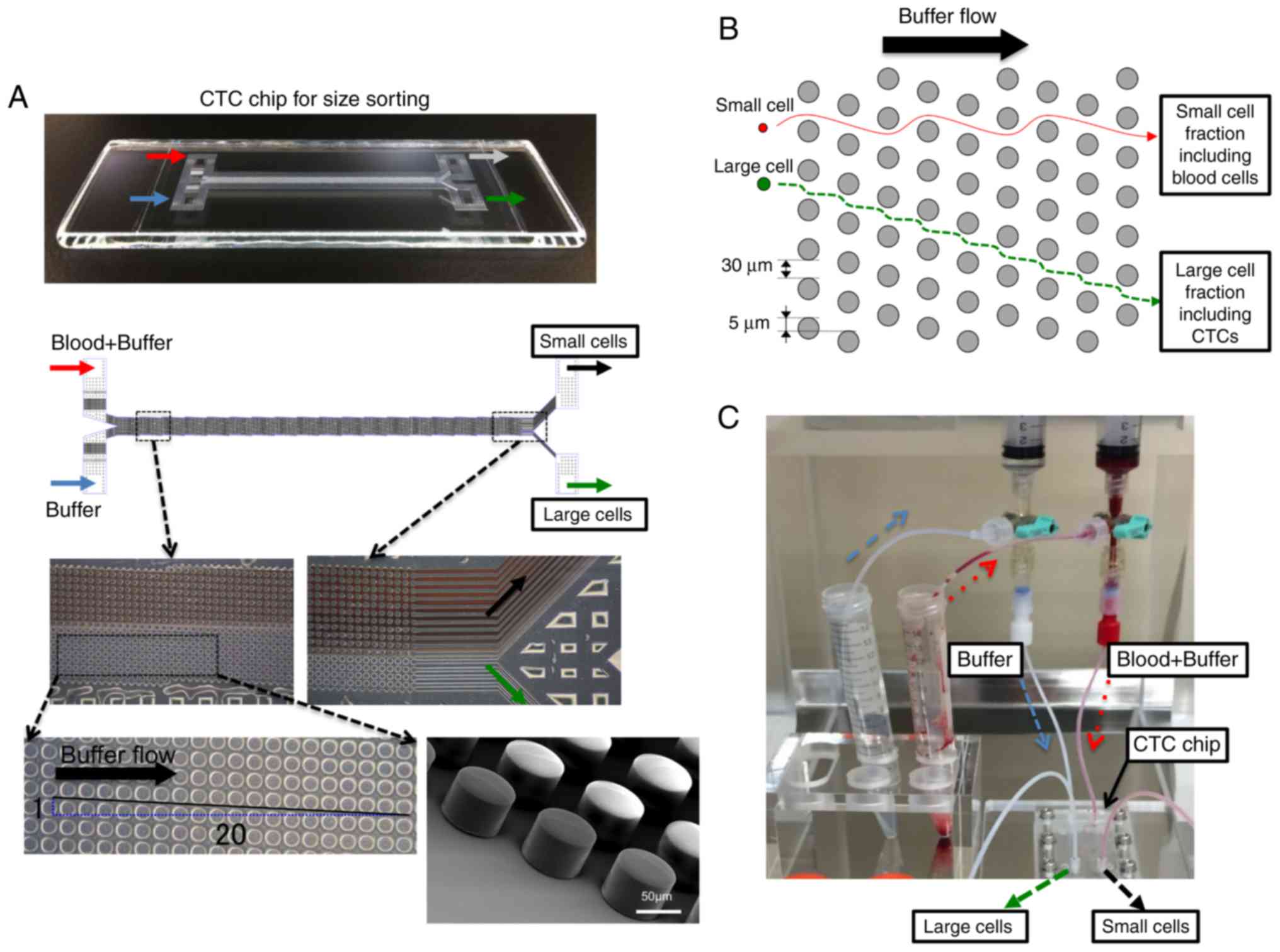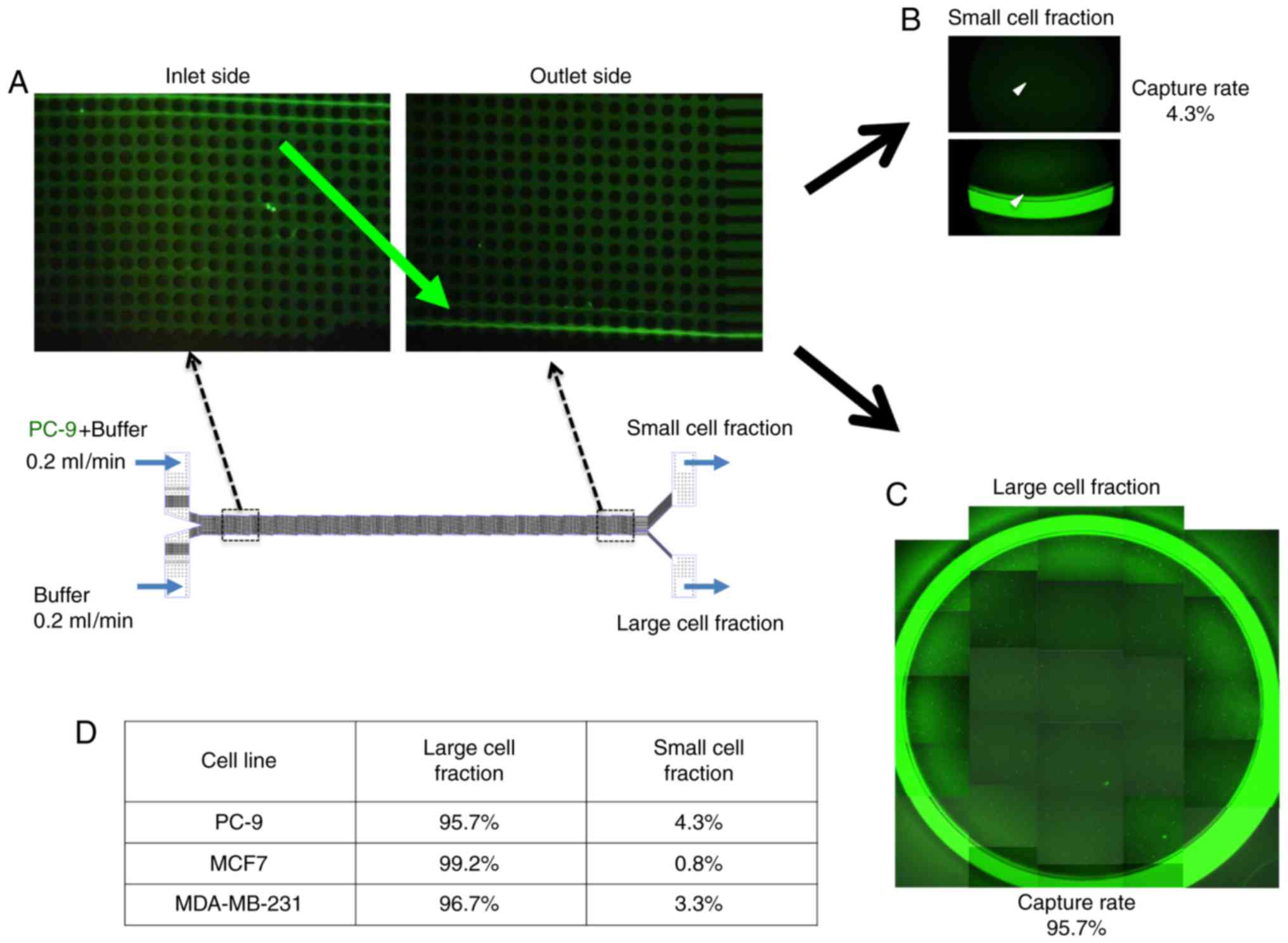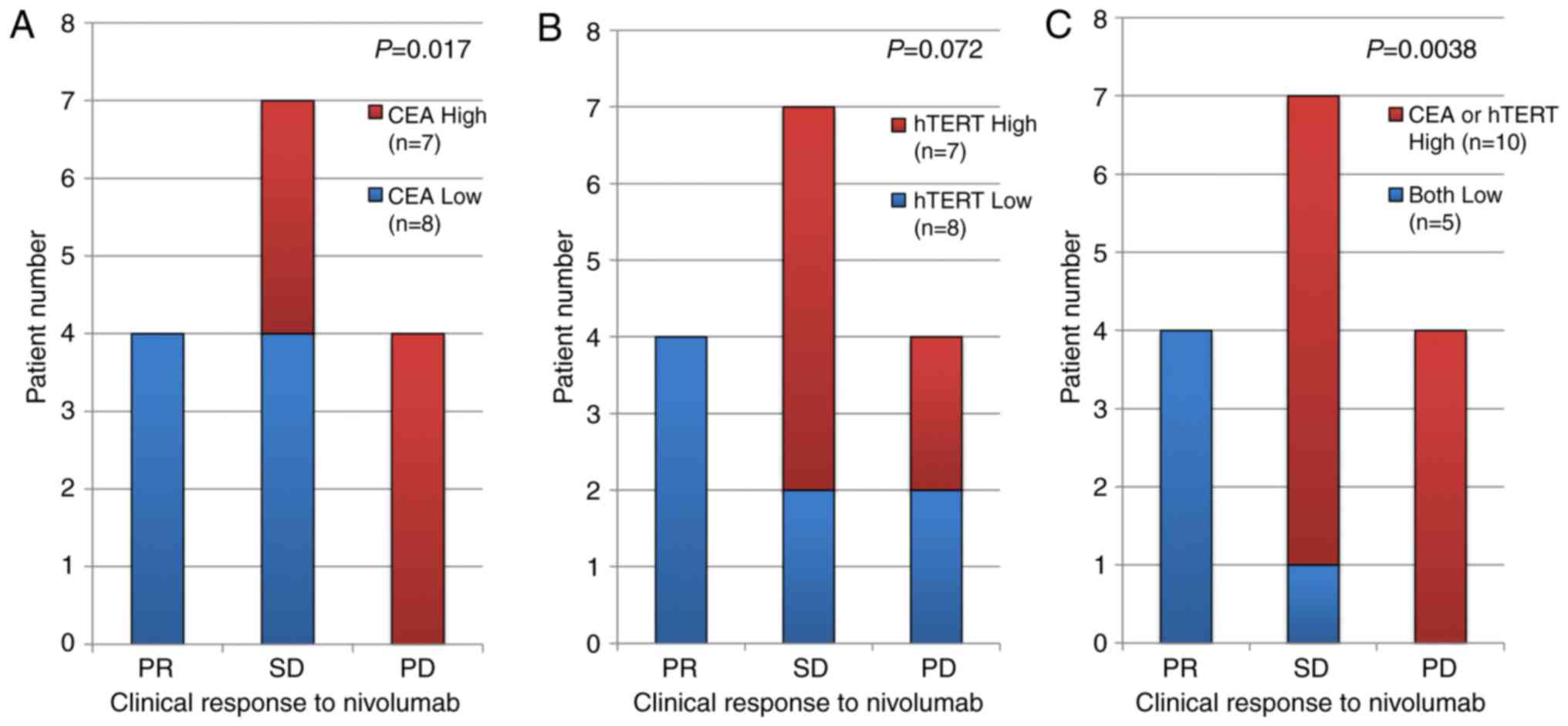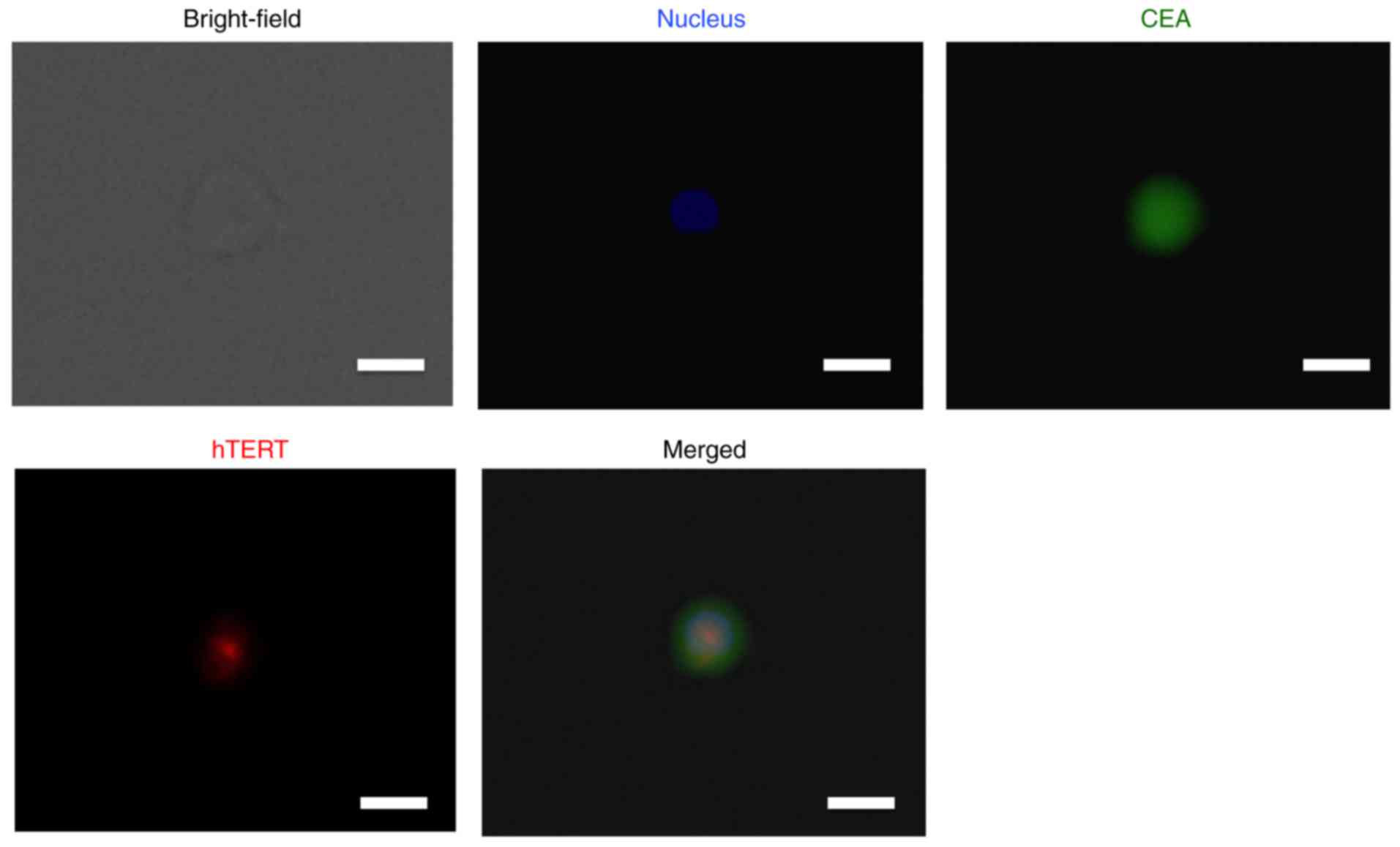High expression of carcinoembryonic antigen and telomerase reverse transcriptase in circulating tumor cells is associated with poor clinical response to the immune checkpoint inhibitor nivolumab
- Authors:
- Published online on: December 20, 2017 https://doi.org/10.3892/ol.2017.7671
- Pages: 3061-3067
-
Copyright: © Bao et al. This is an open access article distributed under the terms of Creative Commons Attribution License.
Abstract
Introduction
Immune checkpoint inhibitors have recently attracted attention as an innovative cancer therapy (1). Programmed death 1 (PD-1)/programmed death ligand-1 (PD-L1) checkpoint inhibitors have been shown to have a continuous clinical effect and low toxicity in some responder patients with several types of recurrent and metastatic diseases (2). Among these, the anti PD-1 monoclonal antibody nivolumab has led to a good clinical response in several cancer patients with lung cancer, melanoma, and renal cell carcinoma (3–6). However, many cancer patients do not gain sufficient benefits even with the anti-PD-1 antibody treatment. Some researchers have proposed that the level of PD-L1 expression and the DNA mismatch-repair status in a tumor are biomarker candidates for predicting the sensitivity to immune checkpoint blockade (3,7). However, invasive tumor sampling is required to determine the protein expression and DNA status in tumor cells. Therefore, further research is needed globally to identify a new blood biomarker that does not require invasive sampling.
In cancer patients, circulating tumor cells (CTCs) in peripheral blood have been identified as a reliable blood tumor marker (8,9). The evaluation of CTCs generally includes an enrichment step and detection processes depending on the CTC characteristics, such as tumor size, density, and cell surface antigen expression, which are conducted using a cytometric-based or polymerase chain reaction (PCR)-based method (10). Nagrath et al (11), were the first to report on a new microfluid device known as a CTC chip that was coated with epithelial cell adhesion molecule (EpCAM) antibody, which could be used to collect CTC-expressing EpCAM from whole blood samples of cancer patients. Because CTCs are known to be larger than nearly all normal blood cells (12,13), the use of only the large cells in blood samples as PCR templates will enable CTCs to be detected more easily using a highly sensitive PCR-based method against the CTC markers carcinoembryonic antigen (CEA), human Telomerase Reverse Transcriptase (hTERT), cytokeratin 19 (CK19), and PD-L1 (9,14–16). Therefore, in the present study, we used a modified CTC chip that was based on a continuous particle separation method (17) to enrich CTCs according to cell size.
The purpose of the present study was to utilize this new CTC chip to collect the large cell fraction from whole blood samples and to find a blood sensitivity marker for nivolumab in advanced, pre-treatment lung cancer patients. To do this, we first examined the sorting efficacy of the new CTC chip using the lung cancer cell line PC-9 and then evaluated the mRNA expression of the CTC markers CEA, hTERT, CK19, and PD-L1 in the large cell fraction of clinical lung cancer patients' blood samples collected by this chip.
Materials and methods
Preparation of a polymeric CTC chip for size sorting
A polymeric CTC chip for size sorting was produced as previously described (18). The chip was set in a holder to enable liquid samples to flow from two inlets to two outlets. Cell suspension samples and mere buffer were sent from each inlet tube into the CTC chip at 0.2 ml/min using a syringe pump (Fig. 1). Two outlets were used to allow the large cell fraction including CTCs to be enriched and blood cells in the small cell fraction to be collected separately. Since the diagonally-arranged microposts cannot influence the flow of small cells, these are carried into the small cell fraction simply as a result of the buffer flow. By contrast, large cells, which include CTCs, are sorted by the microposts based on their size (Fig. 1B and C). Blood samples from advanced lung cancer patients were obtained before nivolumab treatment and collected into ethylenediaminetetraacetic acid (EDTA) blood collection tubes. A 1-ml aliquot of these blood samples was then diluted two times with phosphate-buffered saline (PBS) before size sorting using the CTC chip. Once the large cell fraction had been collected, it was used for further analysis.
Clinical samples and cell lines
This study was prospectively conducted on 15 patients at Gunma University Hospital, Japan, who had advanced lung cancer and were candidates for nivolumab treatment (Table I). The inclusion criteria for this study were as follows: pathologically proven lung cancer; recurrent lung cancer candidate for nivolumab as a result of progressive disease (PD) following chemotherapy; Eastern Cooperative Oncology Group (ECOG) performance status of 0–2, 2-[18F]-fluoro-2-deoxy-D-glucose (18F-FDG) positron emission tomography/computed tomography (PET/CT) scheduled before and after the first cycle of nivolumab therapy; no evidence of concurrent cancer; no uncontrolled diabetes mellitus; no interstitial pneumonia or pulmonary fibrosis; and adequate organ function.
Table I.Clinicopathological characteristics including genetic backgrounds and circulating tumor cell marker expression in 15 patients with lung cancer. |
A pre-treatment 18F-FDG-PET/CT study and blood sampling for CTC sorting were performed as part of the disease evaluation workup prior to the administration of nivolumab. If the tumor size was successfully suppressed by 3 months after the initiation of nivolumab, a subsequent post-treatment PET/CT was considered at around this time at the discretion of the investigator. The clinical response to nivolumab was assessed from the 18F-FDG uptake and chest CT of these patients, and categorized as a partial response (PR), stable disease (SD), or PD according to the Response Evaluation Criteria in Solid Tumors (RECIST). All blood samples were prospectively collected and used in accordance with the Helsinki Declaration and the guidelines of the Gunma University Ethical Review Board for Medical Research Involving Human Subjects after obtaining written informed consent from each patient (approval no. 1404).
The human lung cancer cell line PC-9 and breast cancer cell lines MCF7 and MDA-MB-231 were used to examine the efficacy of the CTC chip for sorting cancer cells according to size. These cell lines were provided by the RIKEN BioResource Center and the American Type Culture Collection. The cells were cultured in Roswell Park Memorial Institute (RPMI) 1640 medium supplemented with 100 units/ml penicillin, 100 units/ml streptomycin, and 10% fetal bovine serum (FBS) in a humidified 5%-CO2 incubator at 37°C. Before cell sorting, these cells were labeled using the CellTrace™ Carboxyfluorescein Diacetate Succinimidyl Ester (CFSE) Cell Proliferation kit (Thermo Fisher Scientific, Inc., Waltham, MA, USA), according to the manufacturer's protocol. The labeled cells were then spiked into the CTC chip and separated into the small or large cell fraction (Fig. 2A), following which the sorted cancer cells in each fraction were counted microscopically.
Reverse transcription-polymerase chain reaction (RT-PCR)
To discover a useful biomarker for predicting patients' sensitivity to the immune checkpoint inhibitor nivolumab, we examined the relationships between the clinical response to nivolumab and several genetic and CTC markers, including epidermal growth factor receptor (EGFR) gene mutation, anaplastic lymphoma kinase (ALK) fusion gene mutation, CEA levels in the serum, and the expressions of existing CTC markers in the large cell fraction including CEA, hTERT, CK19, and PD-L1 in advanced lung cancer patients. RNA extraction and reverse transcription were performed using NucleoSpin RNA XS kit and PrimeScript RT reagent kit with gDNA Eraser (Takara Bio Inc., Tokyo, Japan) according to the manufacturer's protocol. The following gene-specific oligonucleotide primers were designed for PCR: The CEA (66 bp) sense primer 5′-ACCACAGTCACGACGATCAC-3′ and antisense primer 5′-GGAGTTGTTGCTGGTGATG-3′; the hTERT (61 bp) sense primer 5′-GCCTTCAAGAGCCACGTC-3′ and antisense primer 5′-CCACGAACTGTCGCATGT-3′; the CK19 (126 bp) sense primer 5′-GCCACTACTACACGACCATCC-3′ and antisense primer 5′-CAAACTTGGTTCGGAAGTCAT-3′; the PD-L1 (124 bp) sense primer 5′-CTACTGGCATTTGCTGAACG-3′ and antisense primer 5′-TGCAGCCAGGTCTAATTGTTT-3′; and the 18S ribosomal RNA (rRNA) sense primer 5′-GATGGTAGTCGCCGTGCC-3′ and antisense primer 5′-GCCTGCTGCCTTCCTTGG-3′. PCR amplification was performed in a LightCycler® system (Roche Diagnostics, Basel, Switzerland) using the LightCycler 480 SYBR Green I Master kit, as previously described (19). Each of the 40 amplification cycles comprised initial denaturation at 95°C for 10 min, followed by denaturation at 95°C for 10 sec, annealing at 62°C for 10 sec, and elongation at 67°C for 10 sec. The relative expression levels of these genes were obtained by normalizing the amount of mitochondrial RNA (mRNA) to that of 18S rRNA as an endogenous control in each sample.
Fluorescent immunohistochemistry
Sorted cells were seeded on glass coverslips and incubated for 12 h at 37°C. After washing with PBS to exclude non-attached circulating cells such as lymphocytes, the cells were fixed with 100% methanol at −20°C for 15 min, and then incubated with mouse CEA antibody (1:100) (Kyowa Medex Co., Ltd., Tokyo, Japan) and rabbit hTERT antibody (Abcam, Cambridge, CA, USA) for 1 h at room temperature. To detect antibodies against CEA and hTERT, fluorophore-labeled antibodies with anti-mouse fluorescein isothiocyanate (FITC) and anti-rabbit Cy3 specificities (Thermo Fisher Scientific, Inc.) were used for 1 h at room temperature at a dilution of 1:2,000. All sections were then counterstained with 4′,6-diamidino-2-phenylindole (DAPI) and examined under an All-in-One BZ-X710 Fluorescence Microscope (Keyence Corporation, Osaka, Japan). Negative control sections were stained as described above but without the primary antibodies.
Statistical analysis
The relationship between the number of patients with positive marker expression in the large cell fraction and the clinical response to nivolumab was analyzed using Pearson's chi-square test. All statistical analyses were performed using the JMP software package (SAS Institute, Inc., Cary, NC, USA).
Results
The new polymeric microfluid CTC chip effectively collected lung cancer cell line PC-9 into the large cell fraction
To examine the capture efficacy of lung cancer cells using the size-sorting CTC chip device, we spiked the CTC chip with CFSE-labeled PC-9 cells and counted how many entered the small and large cell fractions (Fig. 2). We found that nearly all of the PC-9 cells were moved into the large cell fraction side as they approached the outlet (Fig. 2B and C). Moreover we could validate the sorting efficacy of our CTC chip using breast cancer cell lines MCF7 and MDA-MB-231 similar to PC-9 cells (Fig. 2D).
High expression of CEA and hTERT in the sorted CTCs were associated with poor clinical response to the anti-PD-1 antibody nivolumab
We found that the large cell fraction collected by the CTC chip exhibited high expression of CEA and hTERT. Furthermore, the high expression of CEA was significantly correlated with a poor clinical response to nivolumab and there was also a weak negative correlation between the expression of hTERT and the clinical response, although this was not significant (Fig. 3A and B). Interestingly, both low expressions were strongly correlated with PR clinical response (Fig. 3C).
Immunohistochemical analysis of CEA and hTERT expression in CTCs collected by the size-sorting CTC chip
Once large cells had been collected by the CTC chip, we used fluorescent immunohistochemistry to validate the expression of CEA and hTERT in CTCs. This showed that CTCs of lung cancer expressed the CTC markers CEA and hTERT (Fig. 4). These findings are consistent with the above-mentioned PCR data.
Discussion
In the present study, we designed a new CTC chip that could effectively sort PC-9 cells from a cell suspension in vitro depending on their size. Moreover, we demonstrated that this CTC chip was able to collect the large cells including CTCs from whole blood and that a high expression level of CEA in this fraction was significantly correlated with a poor clinical response in clinical lung cancer patients treated with the anti-PD-1 antibody nivolumab. By contrast, serum CEA levels and the expression of other markers in the large cell fraction, such as the representative epithelial marker CK19 and PD-L1, were not associated with the clinical response to nivolumab.
In general, it is important for cancer cells to avoid immune surveillance not only at the primary site but also in the bloodstream to allow them to survive. However, cancers also have several other hallmarks that help with their survival, including the ability to sustain proliferative signaling; evade growth suppressors; enable replicative immortality and tumor-promoting inflammation; activate invasion and metastasis; induce angiogenesis, genome instability, and mutation; resist cell death; and deregulate cellular energetics (20). It has previously been reported that CEA and hTERT may help in the proliferation, inflammation, angiogenesis, metastasis, resistance to apoptosis, DNA damage repair, and replicative immortality of cancers, which are expected to be important for their survival (20–22). Consequently, it has been suggested that if cancers depend on avoiding immune destruction for their survival, the immune checkpoint inhibitor nivolumab would be an effective treatment, whereas if they are not depending on this, nivolumab may not induce an anti-cancer effect against the cancer cells with other hallmark characteristics. Thus, the use of the method outlined here for detecting CEA and hTERT in CTCs in combination with nivolumab treatment may prove useful for evaluating whether the cancers in advanced lung cancer patients are depending on avoiding immune destruction for their survival.
Several methods for enriching and detecting CTCs in blood samples from clinical cancer patients have previously been reported (8,9,23). Here, we used a CTC chip to enrich CTCs, which is a morphology-based isolation technique that related to the isolation by size of epithelial tumor cells (ISET) method (24), Ficoll isolation for collecting CTC and mononuclear cells, and RosetteSep™ (25). This size-sorting CTC chip was able to enrich lung cancer cells in vitro and in clinical samples. We chose to use a PCR-based method with high sensitivity to detect CTCs from the large cell fraction because CTCs are known to be rare in the blood (one CTC per 106-107 mononuclear cells; [10]). This combination of a size-sorting CTC chip and high-sensitivity PCR-based CTC detection technology may be more suitable for evaluating sensitivity to the immune checkpoint inhibitor nivolumab than the mere detection of CTCs in blood samples.
Commercially available CTC chip using epithelial antibody-based detection methods could capture the cancer cell lines expressing epithelial markers such as MCF7. However, epithelial mesenchymal transition (EMT) induced cancer cells including MDA-MB-231 with highly aggressive phenotypes were not captured by these types of CTC chips (26,27). In contrast, our CTC chip is based on cell size, not epithelial markers. We could demonstrate the high capture ratio of EMT-induced cancer cell line MDA-MB-231 using our CTC chip. From these data, it was suggested that our CTC chip may be more effective in sorting the EMT-induced aggressive CTC than epithelial marker dependent CTC detection.
There is a need to develop a sensitivity marker for immune checkpoint inhibitors including nivolumab in the clinic because these agents are very expensive and have characteristic side effects including an autoimmune response against several organs. It has previously been reported that the overexpression of PD-L1 and somatic mutations that encode immunogenic neoantigens are significantly related to a better response to PD-1/PD-L1 blockade therapy in several cancers (3). However, we are in urgent need of a useful predictive biomarker that uses blood because invasive tumor sampling is currently required to detect PD-L1 expression and mutations for neoantigens in tumor cells. The method outlined in the present study could predict nivolumab sensitivity before treatment using only 1 ml of blood from a cancer patient, making it very promising. However, our data have some limitations: We only validated the immunostaining of CTC markers, CEA, hTERT in a few clinical lung cancer patients in this study, and the limited number of patients that were used in this study; therefore, more patients need to be involved in future studies to elucidate the clinical potential of these methods.
In conclusion, we successfully developed a new polymeric CTC chip that can sort CTCs from blood samples based on their size. The CTCs in the large cell fraction expressed the existing CTC markers CEA and hTERT, the high expression of which was associated with a poor clinical response to the immune checkpoint inhibitor nivolumab in advanced lung cancer patients. Evaluation of CEA and hTERT in CTCs may be a predictive blood marker candidate for patient sensitivity to nivolumab.
Acknowledgements
The present study was supported by JSS Young Researcher Award from Japan Surgical Society, Gunma University Clinical Biobank, and grants-in-Aid for Scientific Research from the Japan Society for the Promotion of Science (JSPS) (grant nos. JP 26461969, JP15K10129, JP15K10085, and JP26350557).
References
|
Sharma P and Allison JP: The future of immune checkpoint therapy. Science. 348:56–61. 2015. View Article : Google Scholar : PubMed/NCBI | |
|
Ma W, Gilligan BM, Yuan J and Li T: Current status and perspectives in translational biomarker research for PD-1/PD-L1 immune checkpoint blockade therapy. J Hematol Oncol. 9:472016. View Article : Google Scholar : PubMed/NCBI | |
|
Meng X, Huang Z, Teng F, Xing L and Yu J: Predictive biomarkers in PD-1/PD-L1 checkpoint blockade immunotherapy. Cancer Treat Rev. 41:868–876. 2015. View Article : Google Scholar : PubMed/NCBI | |
|
Borghaei H, Paz-Ares L, Horn L, Spigel DR, Steins M, Ready NE, Chow LQ, Vokes EE, Felip E, Holgado E, et al: Nivolumab versus docetaxel in advanced nonsquamous non-small-cell lung cancer. N Engl J Med. 373:1627–1639. 2015. View Article : Google Scholar : PubMed/NCBI | |
|
Robert C, Long GV, Brady B, Dutriaux C, Maio M, Mortier L, Hassel JC, Rutkowski P, McNeil C, Kalinka-Warzocha E, et al: Nivolumab in previously untreated melanoma without BRAF mutation. N Engl J Med. 372:320–330. 2015. View Article : Google Scholar : PubMed/NCBI | |
|
Motzer RJ, Escudier B, McDermott DF, George S, Hammers HJ, Srinivas S, Tykodi SS, Sosman JA, Procopio G, Plimack ER, et al: Nivolumab versus everolimus in advanced renal-cell carcinoma. N Engl J Med. 373:1803–1813. 2015. View Article : Google Scholar : PubMed/NCBI | |
|
Le DT, Uram JN, Wang H, Bartlett BR, Kemberling H, Eyring AD, Skora AD, Luber BS, Azad NS, Laheru D, et al: PD-1 Blockade in tumors with mismatch-repair deficiency. N Engl J Med. 372:2509–2520. 2015. View Article : Google Scholar : PubMed/NCBI | |
|
Pantel K and Alix-Panabières C: Circulating tumour cells in cancer patients: Challenges and perspectives. Trends Mol Med. 16:398–406. 2010. View Article : Google Scholar : PubMed/NCBI | |
|
Alix-Panabières C and Pantel K: Challenges in circulating tumour cell research. Nat Rev Cancer. 14:623–631. 2014. View Article : Google Scholar : PubMed/NCBI | |
|
Sun YF, Yang XR, Zhou J, Qiu SJ, Fan J and Xu Y: Circulating tumor cells: Advances in detection methods, biological issues, and clinical relevance. J Cancer Res Clin Oncol. 137:1151–1173. 2011. View Article : Google Scholar : PubMed/NCBI | |
|
Nagrath S, Sequist LV, Maheswaran S, Bell DW, Irimia D, Ulkus L, Smith MR, Kwak EL, Digumarthy S, Muzikansky A, et al: Isolation of rare circulating tumour cells in cancer patients by microchip technology. Nature. 450:1235–1239. 2007. View Article : Google Scholar : PubMed/NCBI | |
|
Dong Y, Skelley AM, Merdek KD, Sprott KM, Jiang C, Pierceall WE, Lin J, Stocum M, Carney WP and Smirnov DA: Microfluidics and circulating tumor cells. J Mol Diagn. 15:149–157. 2013. View Article : Google Scholar : PubMed/NCBI | |
|
Seal SH: A sieve for the isolation of cancer cells and other large cells from the blood. Cancer. 17:637–642. 1964. View Article : Google Scholar : PubMed/NCBI | |
|
Yu Y, Xu G, Cao J, Jin S, Man Y and Shang L: Combination of four gene markers to detect circulating tumor cells in the peripheral blood of patients with advanced lung adenocarcinoma using real-time PCR. Oncol Lett. 5:1400–1406. 2013. View Article : Google Scholar : PubMed/NCBI | |
|
Tanaka F, Yoneda K and Hasegawa S: Circulating tumor cells (CTCs) in lung cancer: Current status and future perspectives. Lung Cancer (Auckl). 1:77–84. 2010.PubMed/NCBI | |
|
Mazel M, Jacot W, Pantel K, Bartkowiak K, Topart D, Cayrefourcq L, Rossille D, Maudelonde T, Fest T and Alix-Panabières C: Frequent expression of PD-L1 on circulating breast cancer cells. Mol Oncol. 9:1773–1782. 2015. View Article : Google Scholar : PubMed/NCBI | |
|
Huang LR, Cox EC, Austin RH and Sturm JC: Continuous particle separation through deterministic lateral displacement. Science. 304:987–990. 2004. View Article : Google Scholar : PubMed/NCBI | |
|
Ohnaga T, Shimada Y, Moriyama M, Kishi H, Obata T, Takata K, Okumura T, Nagata T, Muraguchi A and Tsukada K: Polymeric microfluidic devices exhibiting sufficient capture of cancer cell line for isolation of circulating tumor cells. Biomed Microdevices. 15:611–616. 2013. View Article : Google Scholar : PubMed/NCBI | |
|
Yokobori T, Iinuma H, Shimamura T, Imoto S, Sugimachi K, Ishii H, Iwatsuki M, Ota D, Ohkuma M, Iwaya T, et al: Plastin3 is a novel marker for circulating tumor cells undergoing the epithelial-mesenchymal transition and is associated with colorectal cancer prognosis. Cancer Res. 73:2059–2069. 2013. View Article : Google Scholar : PubMed/NCBI | |
|
Hanahan D and Weinberg RA: Hallmarks of cancer: The next generation. Cell. 144:646–674. 2011. View Article : Google Scholar : PubMed/NCBI | |
|
Beauchemin N and Arabzadeh A: Carcinoembryonic antigen-related cell adhesion molecules (CEACAMs) in cancer progression and metastasis. Cancer Metastasis Rev. 32:643–671. 2013. View Article : Google Scholar : PubMed/NCBI | |
|
Cong Y and Shay JW: Actions of human telomerase beyond telomeres. Cell Res. 18:725–732. 2008. View Article : Google Scholar : PubMed/NCBI | |
|
Alix-Panabières C and Pantel K: Technologies for detection of circulating tumor cells: Facts and vision. Lab Chip. 14:57–62. 2014. View Article : Google Scholar : PubMed/NCBI | |
|
Vona G, Sabile A, Louha M, Sitruk V, Romana S, Schütze K, Capron F, Franco D, Pazzagli M, Vekemans M, et al: Isolation by size of epithelial tumor cells: A new method for the immunomorphological and molecular characterization of circulating tumor cells. Am J Pathol. 156:57–63. 2000. View Article : Google Scholar : PubMed/NCBI | |
|
Busch R, Cesar D, Higuera-Alhino D, Gee T, Hellerstein MK and McCune JM: Isolation of peripheral blood CD4(+) T cells using RosetteSep and MACS for studies of DNA turnover by deuterium labeling. J Immunol Methods. 286:97–109. 2004. View Article : Google Scholar : PubMed/NCBI | |
|
Polyak K and Weinberg RA: Transitions between epithelial and mesenchymal states: Acquisition of malignant and stem cell traits. Nat Rev Cancer. 9:265–273. 2009. View Article : Google Scholar : PubMed/NCBI | |
|
Ohnaga T, Shimada Y, Takata K, Obata T, Okumura T, Nagata T, Kishi H, Muraguchi A and Tsukada K: Capture of esophageal and breast cancer cells with polymeric microfluidic devices for CTC isolation. Mol Clin Oncol. 4:599–602. 2016. View Article : Google Scholar : PubMed/NCBI |













